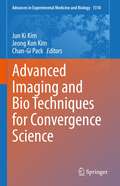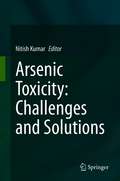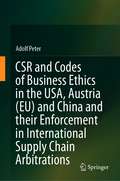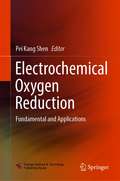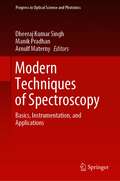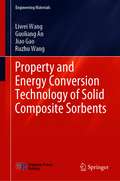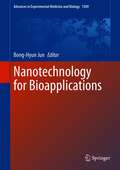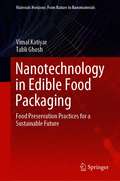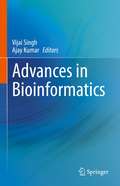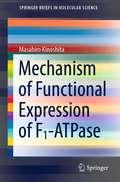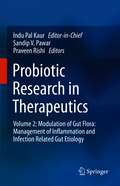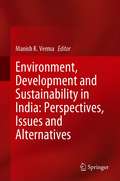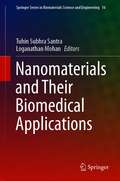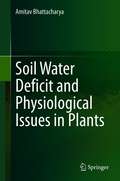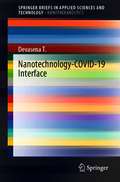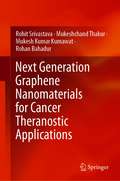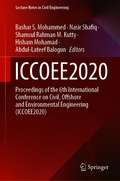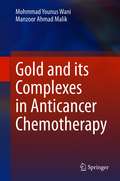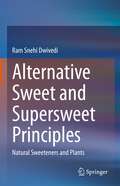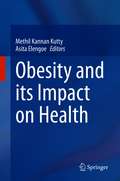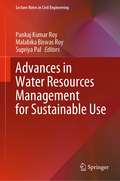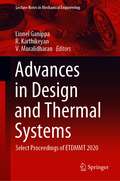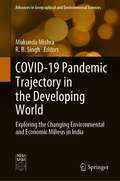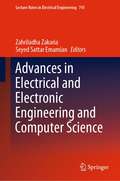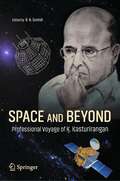- Table View
- List View
Advanced Imaging and Bio Techniques for Convergence Science (Advances in Experimental Medicine and Biology #1310)
by Jun Ki Kim Jeong Kon Kim Chan-Gi PackThis book is a wide-ranging guide to advanced imaging techniques and related methods with important applications in translational research or convergence science as progress is made toward a new era in integrative healthcare. Conventional and advanced microscopic imaging techniques, including both non-fluorescent (i.e., label-free) and fluorescent methods, have to date provided researchers with specific and quantitative information about molecules, cells, and tissues. Now, however, the different imaging techniques can be correlated with each other and multimodal methods developed to simultaneously obtain diverse and complementary information. In addition, the latest advanced imaging techniques can be integrated with non-imaging techniques such as mass spectroscopic methods, genome editing, organic/inorganic probe synthesis, nanomedicine, and drug discovery. The book will be of high value for researchers in the biological and biomedical sciences or convergence science who need to use these multidisciplinary and integrated techniques or are involved in developing new analytical methods focused on convergence science.
Arsenic Toxicity: Challenges and Solutions
by Nitish KumarArsenic (As) is a widely distributed element in the environment having no known useful physiological function in plants or animals. Historically, this metalloid has been known to be used widely as a poison. Effects of arsenic have come to light in the past few decades due to its increasing contamination in several parts of world, with the worst situation being in Bangladesh and West Bengal in India. This edited volume brings together diverse group of environmental science, sustainability and health researchers to address the challenges posed by global mass poisoning caused by arsenic water contamination. The book covers sources of arsenic contamination, and its impact on human health and on prospective remediation both by bioremediation and phytoremediation. Applications of advance techniques such as genetic engineering and nanotechnology are also discussed to resolve the issue of arsenic contamination in ground water and river basins. The book sheds light on this global environmental issue, and proposes solutions to remove contamination through a multi-disciplinary lens and case studies from Bangladesh and India. The book may serve as a reference to environment and sustainability researchers, students and policy makers. It delivers an outline to graduate, undergraduate students and researchers, as well as academicians who are working on arsenic toxicity with respect to remediation and health issues.
CSR and Codes of Business Ethics in the USA, Austria (EU) and China and their Enforcement in International Supply Chain Arbitrations
by Adolf PeterThis book analyzes the implementation of CSR reporting and codes of business conduct and ethics in the legal systems of the USA, Austria and China and their enforcement in international supply chain arbitrations. The book demonstrates that long-term profit maximization is increasingly intertwined with corporate ethics and CSR policies. In order to prevent window-dressing and greenwashing, certain control mechanisms and legal standards are required along the entire supply chain.This book introduces an ethics and CSR system recommending a reward-based whistleblowing mechanism, internal oversight by a CSR and Ethics Committee comprised of independent board members and at least one sustainability expert, and an external, independent and comprehensive assurance of CSR reports provided by auditing firms or newly formed governmental agencies consisting of certified CSR experts.The author emphasizes the significance for supply chain leaders to ensure contractual enforcement of their codes of business ethics and conduct along the supply chain. Against this background, the author created a comprehensive fictitious case scenario covering a supply chain dispute arising from the breach of the supply chain leader’s code of business conduct and ethics by a lower-tier supply chain member. The author acknowledges the fact that in most of the cases the governing law of international supply chain contracts is English law or law based on English law. Thus, the author discusses potential contractual claims for damages arising from a loss of profits caused by a loss of reputation resulting from violations of core provisions of the chain leader’s supplier code of conduct pursuant to English law. As international supply chain disputes usually involve more than two parties, and international arbitration is the ideal means for the resolution of these disputes, the book compares the arbitration rules for consolidations and joinders of some of the most significant international arbitration institutions: SIAC, ICC, AIAC, ICDR, VIAC, CIETAC and HKIAC.The book is directed at legal practitioners, legislators of various jurisdictions, board members of corporations, ethics and compliance officers, academics, researchers and students. It is the author’s main goal that the book serves as an inspirational source for the establishment or the improvement of a corporate ethics and CSR system preventing window-dressing and greenwashing and covering the entire supply chain. Furthermore, it is intended that students develop a deeper understanding for the enforcement of corporate ethics and CSR policies.
Electrochemical Oxygen Reduction: Fundamental and Applications
by Pei Kang ShenThis book discusses systematically the theoretical research and the applications of electrochemical oxygen reduction. Oxygen reduction reaction is a common issue in electrochemistry, but is also an important process involved in the field of energy, cryogenic fuel cells, metal–air cells, oxygen sensors and hydrogen peroxide preparation. This book is divided into 6 chapters; it starts with a description of dynamic mechanisms, followed by a detailed introduction on the related experimental methods and related catalyst preparation technology. By providing the basic methods and testing techniques, and by demonstrating their applications, it helps readers gain a better understanding of oxygen reduction reactions, making it a valuable resource for the industrialization of scientific research achievements. Accordingly, the book appeals to a broad readership, particularly graduate students, those working at universities and research organizations, and industrial researchers.
Modern Techniques of Spectroscopy: Basics, Instrumentation, and Applications (Progress in Optical Science and Photonics #13)
by Dheeraj Kumar Singh Manik Pradhan Arnulf MaternyThe book highlights recent developments in the field of spectroscopy by providing the readers with an updated and high-level of overview. The focus of this book is on the introduction to concepts of modern spectroscopic techniques, recent technological innovations in this field, and current examples of applications to molecules and materials relevant for academia and industry. The book will be beneficial to researchers from various branches of science and technology, and is intended to point them to modern techniques, which might be useful for their specific problems. Spectroscopic techniques, that are discussed include, UV-Visible absorption spectroscopy, XPS, Raman spectroscopy, SERS, TERS, CARS, IR absorption spectroscopy, SFG, LIBS, Quantum cascade laser (QCL) spectroscopy, fluorescence spectroscopy, ellipsometry, cavity-enhanced absorption spectroscopy, such as cavity ring-down spectroscopy (CRDS) and evanescent wave-CRDS both in gas and condensed phases, time-resolved spectroscopy etc. Applications introduced in the different chapters demonstrates the usefulness of the spectroscopic techniques for the characterization of fundamental properties of molecules, e.g. in connection with environmental impact, bio-activity, or usefulness for pharmaceutical drugs, and materials important e.g. for nano-science, nuclear chemistry, or bio-applications. The book presents how spectroscopic techniques can help to better understand substances, which have also great impact on questions of social and economic relevance (environment, alternative energy, etc.).
Property and Energy Conversion Technology of Solid Composite Sorbents (Engineering Materials)
by Liwei Wang Guoliang An Jiao Gao Ruzhu WangSolid chemisorption technology is an effective form of energy conversion for recovering low-grade thermal energy, but limited thermal conductivity and agglomeration phenomena greatly limit its performance. Over the past 20 years, researchers have explored the use of thermal conductive porous matrix to improve heat and mass transfer performance. Their efforts have yielded composite sorption technology, which is now extensively being used in refrigeration, heat pumps, energy storage, and de-NOx applications. This book reviews the latest technological advances regarding composite solid sorbents. Various development methods are introduced and compared, kinetic models are presented, and different cycles are analyzed.Given its scope, the book will benefit experts involved in developing novel materials and cycles for energy conversion, as well as engineers working to develop effective commercialized energy conversion systems based on solid sorption technology
Nanotechnology for Bioapplications (Advances in Experimental Medicine and Biology #1309)
by Bong-Hyun JunThis book documents the tremendous progress in the use of nanotechnology for a range of bioapplications with the aim of providing students, researchers, technicians, and other professionals with an up-to-date overview of the field. After a general introduction to the surface modifications of nanoparticles required for different biological applications, and to the properties of the modified nanoparticles, a series of chapters describe the state of the art in respect of different types of nanoparticle, including silica nanoparticles, fluorescent nanomaterials, metal nanoparticles, magnetic nanoparticles, carbon-based nanostructures, and other novel nanomaterials. Detailed information is supplied on methods of preparation, chemical and physical properties, and current and potential applications. The closing chapters discuss lithography methods for the top-down approach to nanoparticle synthesis and the use of spectroscopic studies as a tool for the characterization of each nanoparticle. Future prospects and challenges for the development of further nanomaterials with bioapplications are also covered.
Nanotechnology in Edible Food Packaging: Food Preservation Practices for a Sustainable Future (Materials Horizons: From Nature to Nanomaterials)
by Vimal Katiyar Tabli GhoshThis volume delivers a systematic overview of nanotechnology in the development of edible food packaging with noteworthy characteristics for improved food quality. It covers current research trends, history outlines, and state of the global marketin combination with associated biomaterials and synthesis strategies. The contents detail the use of various emerging bionanostructured materials such as cellulose nanostructures, chitosan nanostructures, and more.It further deliberates an in-depth discussion on various synthesis strategies and routes for the development of edible food packaging in terms of utilizing various nanosystems such as polymeric nanocomposites, nanoencapsulation systems, nanoemulsion systems, and others.Further, it also discusses experimental practices for bionanostructured and edible packaging materials to check the effectivity in terms of offering enhanced shelf life of food products. It also touches upon the socio-techno challenges in-line with developing edible packaging materials using nanotechnology for high performance packaging application. The book is an excellent guide for both the academia and industry especially early career professionals in edible food packaging sectors for selecting proper biomaterial involvingbiofillers, modifiers, cross linkers, compatibilizers and others to enhance the property of edible food packaging for targeted features.^
Advances in Bioinformatics
by Vijai Singh Ajay KumarThis book presents the latest developments in bioinformatics, highlighting the importance of bioinformatics in genomics, transcriptomics, metabolism and cheminformatics analysis, as well as in drug discovery and development. It covers tools, data mining and analysis, protein analysis, computational vaccine, and drug design. Covering cheminformatics, computational evolutionary biology and the role of next-generation sequencing and neural network analysis, it also discusses the use of bioinformatics tools in the development of precision medicine. This book offers a valuable source of information for not only beginners in bioinformatics, but also for students, researchers, scientists, clinicians, practitioners, policymakers, and stakeholders who are interested in harnessing the potential of bioinformatics in many areas.
Mechanism of Functional Expression of F1-ATPase (SpringerBriefs in Molecular Science)
by Masahiro KinoshitaThis book presents a new view of the mechanism of functional expression of ATP-driven motors (proteins or protein complexes). It is substantially different from the prevailing idea that the motor converts chemical energy to mechanical work. To facilitate understanding, the differences between the new and prevailing views are explained using many illustrations. The book is of interest to those who are not convinced of the notion of chemo–mechanical coupling. The claims presented are the following: The system, which comprises not only the motor but also water, does no mechanical work during the ATP hydrolysis cycle; a protein is moved or a protein in the complex is rotated by the entropic force generated by water. The highlight of the explanation in the book is that the mechanism of unidirectional rotation of the central shaft in F1-ATPase is discussed in detail on the basis of this new view. The hydration entropy of each β subunit to which a specific chemical compound (ATP, ADP and Pi, Pi, or nothing) is bound, the hydration entropy of the α3β3 complex, and the dependence of the hydration entropy of F1-ATPase on the orientation of the γ subunit play essential roles.
Probiotic Research in Therapeutics: Volume 2: Modulation of Gut Flora: Management of Inflammation and Infection Related Gut Etiology
by Indu Pal KaurIn a normal physiological state, several bacteria are present in the human gut that is essential to maintain the normal to healthy gastrointestinal function. Disturbances in this “normal flora” lead to gut inflammation and infection. This volume explores the potential of probiotics, the healthy bacteria, to manage gut-related diseases including gastrointestinal cancers, ulcerative colitis, H. pylori infections, and diarrhea; vaginosis; oral health; airway inflammation; and atopic dermatitis. The concept of designer probiotics, edible vaccines and future scope of research in the field is also presented. The animal models used for studying the benefits of probiotics in gut inflammation are described for beginners.
Environment, Development and Sustainability in India: Perspectives, Issues and Alternatives
by Manish K. VermaThis book provides a comprehensive account of asymmetric linkage in the trilogy of environment, development and sustainability and its impact on society. It examines varied perspectives and issues of development related to environmental destruction and sustainability challenges. By examining the recent trends of development and recording the dilemmas which are creating ecological imbalances, it explores some alternative ways of development to achieve sustainability. Divided into three parts, it has a broad canvass. The first section examines critically the ‘perspectives’ on ecology, practice and ethics, rural development and man–forest interaction in the metropolis. ‘Issues’ of dams, river, agricultural distress, environmental migration, eco-tourism, ecological conservation and land acquisition are assessed in part second. ‘Alternative’ means of development is explored in part third by incorporating chapters on the constructed wetland, biofuels, subsistence economy, water and traditional knowledge practice. This interdisciplinary book is of immense significance to academicians, researchers, postgraduate and graduate-level students of social sciences and environmental studies; policymakers, development practitioners and NGOs working in the area of environment and development.
Nanomaterials and Their Biomedical Applications (Springer Series in Biomaterials Science and Engineering #16)
by Tuhin Subhra Santra Loganathan MohanThis book highlights the evolution of, and novel challenges currently facing, nanomaterials science, nanoengineering, and nanotechnology, and their applications and development in the biological and biomedical fields. It details different nanoscale and nanostructured materials syntheses, processing, characterization, and applications, and considers improvements that can be made in nanostructured materials with their different biomedical applications. The book also briefly covers the state of the art of different nanomaterials design, synthesis, fabrication and their potential biomedical applications. It will be particularly useful for reading and research purposes, especially for science and engineering students, academics, and industrial researchers.
Soil Water Deficit and Physiological Issues in Plants
by Amitav BhattacharyaThis book explores the impact of soil water deficiency on various aspects of physiological processes in plants. The book explains the effects under soil water deficit condition such as lowering of plant water content, disturbance in carbon metabolism such in photosynthesis, photorespiration and respiration as well as effects of soil water deficit on nitrogen metabolism. The book also educates the readers about, mineral nutrition under soil water deficit condition and roles of different nutrient to overcome water deficit. Changes in growth and development pattern of plant under soil water deficit condition and effects on growth and development are elaborated. This book is of interest to teachers, researchers, scientists in botany and agriculture. Also the book serves as additional reading material for undergraduate and graduate students of agriculture, forestry, ecology, soil science, and environmental sciences. National and international agricultural scientists, policy makers will also find this to be a useful read.The in depth description of the major physiological issues in plants under soil water deficit that are presented in this book will help breeders tailoring crops for desirable physiological survival traits in the face of increasing soil water deficit. This book is an impactful addition to the library of any faculty members, researchers, agricultural policy planner, post graduate or student studying in plant physiology, biochemistry, microbiology and other subjects related to crop husbandry.
Nanotechnology-COVID-19 Interface (SpringerBriefs in Applied Sciences and Technology)
by Devasena T.This book highlights the role of nanotechnology concepts in the management of COVID-19 pandemic. The book covers different aspects of the causative agent SARS CoV2 (Severe Acute Respiratory Syndrome Coronavirus-2) and the COVID-19 pandemic with a special emphasis on nanotechnology. It discusses the origin and history of SARS CoV2 and the outbreak of COVID-19 and highlights the geographical mutations in the SARS CoV2 virus genome, providing information about the structural features, antigenicity and the life cycle of SARS CoV2. The book provides an insight into nanotechnology–virology interface and explains how nanomaterials link the gap between the vital phases of SARS CoV2 life cycle and the four modalities of COVID-19 management viz sensing/diagnosis, therapy, prevention and self-protection. Further, the existing and promising diagnostic tools for detection of COVID-19 are discussed with an emphasis on nano PCR, nanoimmunosensors, biobarcode assay and point of care approach and also describe the nanoparticles involved in the CT imaging of lungs and SFHI (Spatial Frequency Hetrodyne Imaging) for diagnosis of SARS COV2 infection. The book concludes with details about translational medicine and explains the types of SARS CoV2 vaccines, stages of COVID-19 vaccine development and possible nanovaccines for COVID-19, followed by the description on biopharmaceutical companies involved in the production of SARS CoV2 vaccines.
Next Generation Graphene Nanomaterials for Cancer Theranostic Applications
by Rohit Srivastava Mukeshchand Thakur Mukesh Kumar Kumawat Rohan BahadurThis book focuses on the use of graphene and its derivatives for application in cancer diagnosis and therapy. Readers are introduced to graphene nanomaterial history, synthesis procedures, properties, modifications, and applications in cancer research and development. The wide-ranging properties of graphene nanomaterials can be utilized for various cancer therapeutic and diagnostic applications. The contents discuss these applications with simple graphical overviews and provide comprehensive detail for a better understanding of the state of the art. The book will be of interest to professionals and academic researchers alike.
ICCOEE2020: Proceedings of the 6th International Conference on Civil, Offshore and Environmental Engineering (ICCOEE2020) (Lecture Notes in Civil Engineering #132)
by Bashar S. Mohammed Nasir Shafiq Shamsul Rahman M. Kutty Hisham Mohamad Abdul-Lateef BalogunThis book contains papers presented in the 6th International Conference on Civil, Offshore & Environmental Engineering (ICCOEE2020) under the banner of World Engineering, Science & Technology Congress (ESTCON2020) will be held from 13th to 15th July 2021 at Borneo Convention Centre, Kuching, Sarawak, Malaysia. This proceeding contains papers presented by academics and industrial practitioners showcasing the latest advancements and findings in civil engineering areas with an emphasis on sustainability and the Industrial Revolution 4.0. The papers are categorized under the following tracks and topics of research:1. Resilient Structures and Smart Materials2. Advanced Construction and Building Information Modelling3. Smart and Sustainable Infrastructure4. Advanced Coastal and Offshore Engineering5. Green Environment and Smart Water Resource Management Systems
Gold and its Complexes in Anticancer Chemotherapy
by Mohmmad Younus Wani Manzoor Ahmad MalikThis book presents an overview of cancer and the genesis, and development of different treatment strategies and modalities against cancer. The emergence of gold and its complexes as promising anticancer chemotherapeutic agents have the potential to substitute or replace the platinum based chemotherapeutic agents. Gold complexes have demonstrated considerable anti-proliferative properties, chiefly attributed to their anti-mitochondrial effects, they make gold complexes excellent candidates as anti-cancer agents compared to their platinum-based counterparts. This book provides a critical review of recent advances made in the development of gold complexes as anti-cancer agents. In this context, it examines a number of different ligand architectures, provides comprehensive information on gold complexes’ mechanism of action and toxicity issues and, in closing, outlines future research directions.
Alternative Sweet and Supersweet Principles: Natural Sweeteners and Plants
by Ram Snehi DwivediThis book compiles the latest information on different kinds of natural, plant-based super sweeteners. A book on alternative, natural super sweeteners is extremely timely and useful, especially, in light of the decreasing cultivable area, ever increasing demand for sucrose, and the well identified ills of sugar consumption. Every year more than 5.0 million people die due to diabetes and diabetes-associated diseases like cardiovascular, kidney disorder, liver cancer etc. This book describes the use of non-saccharide super sweet principles to counter such maladies. The readers will get an in-depth understanding of different kinds of sweeteners, molecular basis of sweetness, their general classification, plant source with photo-plates etc. The chapters explain different kinds of super-sweet principles. This book emphasizes on the propagation, cultivation and conservation of NSSS plants (NSSSP) and extraction of super sweet principles and granting of generally recognised as safe (GRAS) certificate to sweeteners. The concluding chapter describes the eco-physiological difference between saccharide super sweet and non saccharide sweet plants. The book also describes commercial production of selected potential Natural Super Sweeteners. This book will be of great interest to researchers, extension workers as well as postgraduate students in Food science nutrition, ayurveda, plant physiology, Unani, naturopathy, biochemistry and plant breeding. It would also be of interest to industry stakeholders in sweetener industry and alternative sweetener manufactures.
Obesity and its Impact on Health
by Methil Kannan Kutty Asita ElengoeThis book summarizes the effects of obesity on health and its correlation with a wide range of debilitating and life-threatening conditions in humans. It discusses the possible pathological mechanisms that are involved in the development of obesity and highlights obesity-associated molecular mechanisms that contribute to reproductive dysfunctions in men and women. The book provides mechanistic insights on the role of obesity in cardiovascular and respiratory disorders, and examines the role of the complementary molecular mechanism of the gut microbiota in the development of obesity. It also reviews the interaction between the metabolic system and immune cells in the pathogenesis of obesity-associated diseases. Lastly, it assesses the latest advances in nanomedicine as an emerging strategy for the treatment of obesity.
Advances in Water Resources Management for Sustainable Use (Lecture Notes in Civil Engineering #131)
by Pankaj Kumar Roy Malabika Biswas Roy Supriya PalThis book presents the innovative ideas and technical expertise for the sustainable solution in the field of water resources. It covers various topics on sustainable water resources management under climate change where researchers and professionals have shared their experience, innovative ideas, issues, recent trends and future directions in field of water resources engineering, science and technology. This book culminates the importance of achieving the ways towards water security and espouse targets and measures that will allow the end-user to meet this challenge in conjunction. It is a compendium of research articles pertaining to the mitigation of water crisis, surface and groundwater management, watershed management and modelling, case studies related to wetland vulnerability, water pollution, water quality, extreme climate hazards and others issues and its sustainable diminution through ingenious ideas and technologies that will incur valuable information to the stakeholders in the society. Given its scope, this book will be useful for the researchers and professionals.
Advances in Design and Thermal Systems: Select Proceedings of ETDMMT 2020 (Lecture Notes in Mechanical Engineering)
by Lionel Ganippa R. Karthikeyan V. MuralidharanThe book presents the select peer-reviewed proceedings of the International Conference on Emerging Trends in Design, Manufacturing, Materials and Thermal Sciences (ETDMMT 2020). The contents focus on latest research in product design, CAD/CAE/CFD, robotic systems, neural networks, thermal systems, alternative fuels, propulsion systems, environmental issues related to combustion, autonomous vehicles and alternative energy applications. In addition, the book also covers recent advances in automotive engineering and aerospace technologies. Given the range of contents covered, this book can be useful for students, researchers as well as practicing engineers.
COVID-19 Pandemic Trajectory in the Developing World: Exploring the Changing Environmental and Economic Milieus in India (Advances in Geographical and Environmental Sciences)
by Mukunda Mishra R. B. SinghWe are witnessing an unprecedented global outbreak of COVID-19, which has been devastating in its consequences. Beyond the acute health hazard, the pandemic has carried with it other threats for mankind associated with the human economy, society, culture, psychology and politics. Amidst these multifarious dimensions of the pandemic, it is high time for global solidarity to save humankind.Human society, its ambient environment, the process of socio-economic development, and politics and power – all are drivers to establish the world order. All these parameters are intimately and integrally related. The interconnections of these three driving forces have a significant bearing on life, space and time. In parallel, the interrelationship between all these drivers is dynamic, and they are changed drastically with time and space. The statistics serve to align the thought, based on which social scientists need to understand the prevailing equation to project the unforeseen future. The trajectory of the future world helps in planning and policymaking with a scientific direction.The practitioners of all academic disciplines under the umbrella of the social sciences need a common platform to exchange ideas that may be effective in the sustainable management of the crisis and the way forward after it is mitigated. This book provides multidisciplinary contributions for expressing the solidarity of academic knowledge to fight against this global challenge. It is crucial that there should be an on-going discussion and exchange of ideas, not only from the perspective of the current times but keeping in view the preparedness for unforeseen post-COVID crises as well.
Advances in Electrical and Electronic Engineering and Computer Science (Lecture Notes in Electrical Engineering #741)
by Zahriladha Zakaria Seyed Sattar EmamianThis book highlights the recent research works on computer science, electrical and electronic engineering which was presented virtually during the 2nd International Conference on Computer Science, Electrical & Electronic Engineering (ICCEE 2020) on 17th and 18th August 2020. Written by leading researchers and industry professionals, the papers highlight recent advances and address current issues in the respective fields.
Space and Beyond: Professional Voyage of K. Kasturirangan
by B. N. SureshThis book discusses the journey of Dr. K Kasturirangan, who shares his experience during his long tenure at ISRO including the Chairmanship of ISRO, subsequently membership of the Rajya Sabha, the Planning Commission and many other responsibilities. Over the past five decades of public and professional service to the nation, Dr. Kasturirangan has graduated from a young researcher in astrophysics working under Vikram Sarabhai to leading India’s space program (ISRO), being entrusted by five successive Prime Ministers, besides dealing with several other domains of responsibilities beyond space, all of which have significantly impacted India’s development. This book centers around select 12 public invited lectures, Dr. Kasturirangan delivered ranging from developing hi-tech space systems, to managing an organization as intricate as ISRO which was guided by the wisdom of mentors, including Vikram Sarabhai, M G K Menon, Satish Dhawan and U. R. Rao, to tackling multi-faceted socio-economic issues, including India’s nuclear deal, report headed by him on the Western Ghats ecosystem, and the new National Education Policy 2020. Scientists, historians, policy makers, management strategists, journalists, or anyone with a keen interest in understanding the processes behind such large-scale science, technology and socio-economic endeavors – right from planning, creating appropriate institutional mechanisms, working with multiple stakeholders to ensure that these programs deliver tangible benefits to society, articulating these benefits with clarity to political leaders to assure public support – will find this book deeply instructive and illuminating. It will be of interest to the scientific, education and management community as well as to policy makers and researchers affiliated with multifaceted developmental issues.
